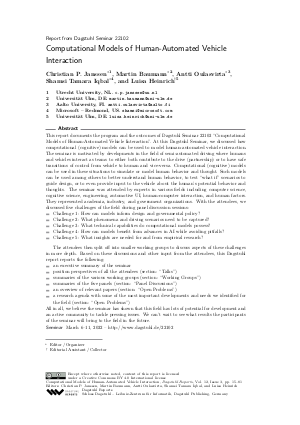Computational Models of Human-Automated Vehicle Interaction (Dagstuhl Seminar 22102)
Authors Christian P. Janssen, Martin Baumann, Antti Oulasvirta, Shamsi Tamara Iqbal, Luisa Heinrich and all authors of the abstracts in this report
-
Part of:
Issue:
Dagstuhl Reports, Volume 12, Issue 3
Part of: Volume: Dagstuhl Reports, Volume 12
Part of: Journal: Dagstuhl Reports (DagRep) - License:
 Creative Commons Attribution 4.0 International license
Creative Commons Attribution 4.0 International license
- Publication Date: 2022-11-14
File

PDF
DagRep.12.3.15.pdf
- Filesize: 7.42 MB
- 67 pages
Document Identifiers
Subject Classification
ACM Subject Classification
- Human-centered computing → HCI design and evaluation methods
- Human-centered computing → HCI theory, concepts and models
- Human-centered computing → Human computer interaction (HCI)
- Human-centered computing
- Human-centered computing → Interactive systems and tools
- Human-centered computing → User models
Keywords
- artificial intelligence
- automated vehicles
- cognitive science
- computational models
- human-automation interaction
- human-computer interaction
- semi-automated vehicles
- user models
Metrics
- Access Statistics
-
Total Accesses (updated on a weekly basis)
0Document
0Metadata
Abstract
This report documents the program and the outcomes of Dagstuhl Seminar 22102 "Computational Models of Human-Automated Vehicle Interaction". At this Dagstuhl Seminar, we discussed how computational (cognitive) models can be used to model human-automated vehicle interaction. The seminar is motivated by developments in the field of semi-automated driving where humans and vehicles interact as teams to either both contribute to the drive (partnership) or to have safe transitions of control from vehicle to human and vice-versa. Computational (cognitive) models can be used in these situations to simulate or model human behavior and thought. Such models can be used among others to better understand human behavior, to test "what if" scenarios to guide design, or to even provide input to the vehicle about the human’s potential behavior and thoughts. The seminar was attended by experts in various fields including computer science, cognitive science, engineering, automotive UI, human-computer interaction, and human factors. They represented academia, industry, and government organizations. With the attendees, we discussed five challenges of the field during panel discussion sessions: - Challenge 1: How can models inform design and governmental policy? - Challenge 2: What phenomena and driving scenarios need to be captured? - Challenge 3: What technical capabilities do computational models possess? - Challenge 4: How can models benefit from advances in AI while avoiding pitfalls? - Challenge 5: What insights are needed for and from empirical research? The attendees then split off into smaller working groups to discuss aspects of these challenges in more depth. Based on these discussions and other input from the attendees, this Dagstuhl report reports the following: - an executive summary of the seminar - position perspectives of all the attendees (section: "Talks") - summaries of the various working groups (section: "Working Groups") - summaries of the five panels (section: "Panel Discussions") - an overview of relevant papers (section: "Open Problems") - a research agenda with some of the most important developments and needs we identified for the field (section: "Open Problems") All in all, we believe the seminar has shown that this field has lots of potential for development and an active community to tackle pressing issues. We can't wait to see what results the participants of the seminar will bring to the field in the future.
Cite As Get BibTex
Christian P. Janssen, Martin Baumann, Antti Oulasvirta, Shamsi Tamara Iqbal, and Luisa Heinrich. Computational Models of Human-Automated Vehicle Interaction (Dagstuhl Seminar 22102). In Dagstuhl Reports, Volume 12, Issue 3, pp. 15-81, Schloss Dagstuhl – Leibniz-Zentrum für Informatik (2022)
https://doi.org/10.4230/DagRep.12.3.15
BibTex
@Article{janssen_et_al:DagRep.12.3.15,
author = {Janssen, Christian P. and Baumann, Martin and Oulasvirta, Antti and Iqbal, Shamsi Tamara and Heinrich, Luisa},
title = {{Computational Models of Human-Automated Vehicle Interaction (Dagstuhl Seminar 22102)}},
pages = {15--81},
journal = {Dagstuhl Reports},
ISSN = {2192-5283},
year = {2022},
volume = {12},
number = {3},
editor = {Janssen, Christian P. and Baumann, Martin and Oulasvirta, Antti and Iqbal, Shamsi Tamara and Heinrich, Luisa},
publisher = {Schloss Dagstuhl -- Leibniz-Zentrum f{\"u}r Informatik},
address = {Dagstuhl, Germany},
URL = {https://drops.dagstuhl.de/entities/document/10.4230/DagRep.12.3.15},
URN = {urn:nbn:de:0030-drops-172680},
doi = {10.4230/DagRep.12.3.15},
annote = {Keywords: artificial intelligence, automated vehicles, cognitive science, computational models, human-automation interaction, human-computer interaction, semi-automated vehicles, user models}
}
